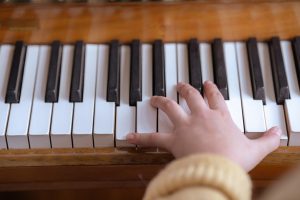
Probably the most popular question from students is “why do we need to practice regularly?” And from parents it’s “how/how often should my child practice?” To get better and as much as you can is the simple answer that doesn’t really seem to answer anything. The long and helpful answer is that the how and why are intertwined.
At our studio we split the class into three sections and ask students to practice the same way – technique, theory, and songs.
1) Technique: Practicing technique has several goals: to strengthen muscles; increase hand-eye coordination; and create muscle memory. Practicing technique gives you an isolated time to focus on minutia, so that your fingers will do what you want them to in a live situation. Technique practice often involves drill-like exercises specific to each instrument such as scales. The great thing about practicing scales is that it not only isolates note patterns specific to the instrument and builds strength and accuracy, but serves as a basis for an understanding theory and harmony.
2) Theory: The ultimate goal of music theory is learning to read and speak the language of music. For beginners, theory is best taught through graded method books which focus on learning notation, rhythm, chords and basic song structure. For more advanced students a more nuanced knowledge of theory as well as music history is needed. Digging into the past of a specific style of music and learning its idioms is invaluable for technique, theory, and having a real understanding of the music.
3) Songs: Learning a specific song encapsulates all three parameters – technique, theory and history. In addition, it involves training our ears to listen and imitate.It is important to listen to a recording of the song over and over, and envision your hands playing the piece in your “mind’s eye.”
As for the “how” of practicing, a basic breakdown would be:
- STRETCH!! Playing and practicing can be compared to sports, and warming up can be a life saver!
- Next, practice basic techniques which can include scales and other exercises.
- Move onto your method book to review the assigned work for the week.
Practice whatever song you’re working on. Isolate trouble spots in the song (don’t just play through it many times), see if you can play the song without looking at the page (“get it off the page”), and plan a performance night where you play through all of the songs you’ve learned so far.
For the amount of time one should practice, we find that students under 7 need an adult to help with understanding and for motivation. 10-20 minutes a day, 3-4 times a week is fine. Between ages 7-10, an adult should just be there to check that they are practicing the proper material with 15-30 minutes a day, 4-5 times a week. Ideally, students 12 years and up don’t require much supervision and should practice 30 minutes and up and day, and 5 days a week.
